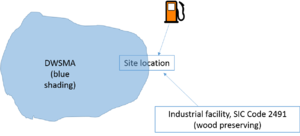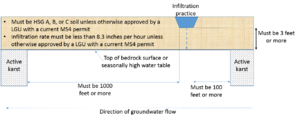
When infiltration is not authorized under a stormwater permit


Designed infiltration of stormwater is highly encouraged and generally preferred by regulatory agencies and stormwater practitioners. However, under certain conditions designed infiltration of stormwater presents an unacceptable risk to groundwater. Part III.D of the Construction Stormwater permit includes several prohibitions to infiltration of stormwater.
Infiltration is prohibited when the infiltration system will be constructed in
- areas that receive discharges from vehicle fueling and maintenance;
- areas with less than three (3) feet of separation distance from the bottom of the infiltration system to the elevation of the seasonally saturated soils or the top of bedrock;
- areas that receive discharges from industrial facilities which are not authorized to infiltrate industrial stormwater under an NPDES/SDS Industrial Stormwater Permit issued by the MPCA;
- areas where high levels of contaminants in soil or groundwater will be mobilized by the infiltrating stormwater;
- areas of predominately Hydrologic Soil Group D (clay) soils unless allowed by a local unit of government with a current MS4 permit;
- areas within 1,000 feet up‐gradient, or 100 feet down‐gradient of active karst features unless allowed by a local unit of government with a current MS4 permit;
- areas within a Drinking Water Supply Management Area (DWSMA) as defined in Minn. R. 4720.5100, subp. 13., unless allowed by a local unit of government with a current MS4 permit; and
- areas where soil infiltration rates are more than 8.3 inches per hour unless soils are amended to slow the infiltration rate below 8.3 inches per hour or as allowed by a local unit of government with a current MS4 permit.
Each of these is discussed in greater detail below.
Discharges from vehicle fueling areas
Vehicle fueling areas represent a relatively high risk for spills involving highly mobile and toxic chemicals. Gasoline compounds in particular are mobile and contain chemicals that represent a significant risk to human health and the environment (e.g. benzene). Standard designs for infiltration practices will not be adequate to treat runoff with high concentrations of these chemicals and the chemicals will readily leach through the underlying soil, thus representing a risk to groundwater. For more information, see the section potential stormwater hotspots.
Shallow bedrock and shallow water table
Stormwater infiltrating below an infiltration practice may require additional treatment even after passing through the media or soil in the infiltration practice. The distance needed to provide adequate treatment varies with soil and pollutants in the infiltrating water. For example, soils with high clay or organic matter contents typically retain pollutants better than sandy soils having little organic matter. A separation distance of 3 feet is commonly used for other types of infiltrating water, such as water infiltrating from a septic drain field. A separation distance of 5 feet is recommended, particularly in sandy soils, but a minimum of 3 feet separation from either bedrock or the seasonally high water table is required. For more information see the pages on shallow soils and depth to bedrock and shallow groundwater.